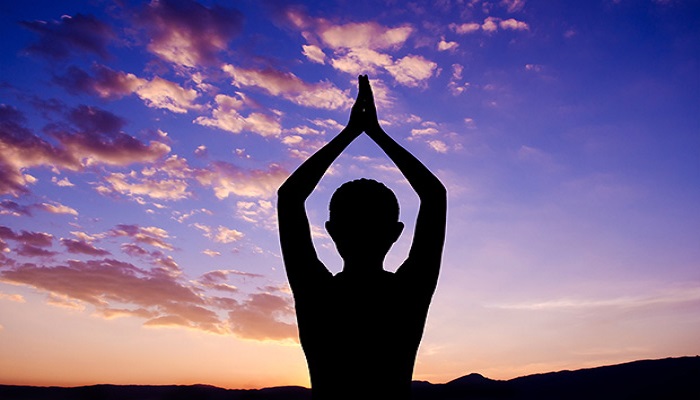
Doing yoga once a day helps improve and strengthen our body, mind and cleanse our soul. Here is a yoga pose for the day.
Bound Angle Pose

One of the best hip openers around, Bound Angle Pose counteracts chair- and cardio-crunched hips.
(BAH-dah cone-AHS-anna)
baddha = bound
kona = angle
Bound Angle Pose: Step-by-Step Instructions
Step 1
Sit with your legs straight out in front of you, raising your pelvis on a blanket if your hips or groins are tight. Exhale, bend your knees, pull your heels toward your pelvis, then drop your knees out to the sides and press the soles of your feet together.
Step 2
Bring your heels as close to your pelvis as you comfortably can. With the first and second finger and thumb, grasp the big toe of each foot. Always keep the outer edges of the feet firmly on the floor. If it isn’t possible to hold the toes, clasp each hand around the same-side ankle or shin.
Step 3
Sit so that the pubis in front and the tailbone in the back are equidistant from the floor. The perineum then will be approximately parallel to the floor and the pelvis in a neutral position. Firm the sacrum and shoulder blades against the back and lengthen the front torso through the top of the sternum.
Step 4
Never force your knees down. Instead, release the heads of the thigh bones toward the floor. When this action leads, the knees follow.
Step 5
Stay in this pose anywhere from 1 to 5 minutes. Then inhale, lift your knees away from the floor, and extend the legs back to their original position.
Pose Information
Sanskrit Name
Baddha Konasana
Pose Level: 1
Contraindications and Cautions
Groin or knee injury: Only perform this pose with blanket support under the outer thighs.
Modifications and Props
To understand the release of the heads of the thigh bones, fold two blankets and put one under each outer thigh, supporting the thighs an inch or so above their maximum stretch. Then lay a 10-pound sandbag on each inner groin, parallel to the crease between the thigh and pelvis. Release the thigh heads away from the weight, and let them sink into the blankets. Do not use the bags unless the thighs are supported.
Deepen the Pose
Imagine you have two partners, each pressing inward (toward the pelvis) on a knee. From the middle of your sacrum, push out along the outer thighs against this imaginary resistance. Then push the heels firmly together from the knees.
Preparatory Poses
Supta Padangusthasana
Virasana
Vrksasana
Follow-up Poses
Standing poses and most seated twists and forward bends.
Beginner’s Tip
It can be difficult to lower the knees toward the floor. If your knees are very high and your back rounded, be sure to sit on a high support, even as high as a foot off the floor.
Benefits
Stimulates abdominal organs, ovaries and prostate gland, bladder, and kidneys
Stimulates the heart and improves general circulation
Stretches the inner thighs, groins, and knees
Helps relieve mild depression, anxiety, and fatigue
Soothes menstrual discomfort and sciatica
Helps relieve the symptoms of menopause
Therapeutic for flat feet, high blood pressure, infertility, and asthma
Consistent practice of this pose until late into pregnancy is said to help ease childbirth.
Traditional texts say that Baddha Konasana destroys disease and gets rid of fatigue.
Partnering
A partner can help you learn how to work the inner thighs in this pose. Perform Baddha Konasana. Loop a strap over each groin, with the free ends of the straps leading away from your back torso. Have your partner sit behind you and pull on the straps (perpendicular to the line of the thighs). Your partner can also press one foot lightly against the back of your pelvis at the same time. Lean slightly forward, releasing the heads of the thigh bones away from the straps.
Variations
Exhale and lean your torso forward between the knees. Remember to come forward from the hip joints, not the waist. Bend your elbows and push them against the inner thighs or calves (but never on the knees). If your head doesn’t rest comfortably on the floor, support it on a block or the front edge of a chair seat.

Post Your Comments